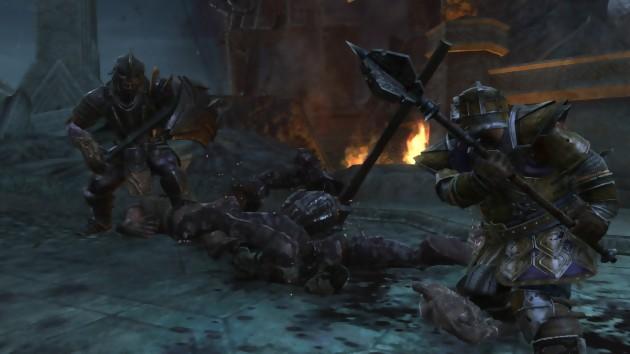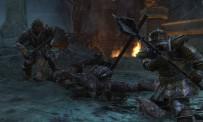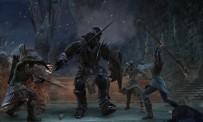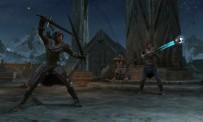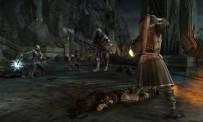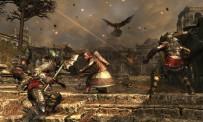 Warner Bros. Interactive therefore takes up the policy that was that of Electronic Arts for The Third Age on PlayStation 2: to give an alternative to the events described in the films and the books by discovering what happens in parallel with the adventures of the Fellowship of the Ring. We therefore do not play one of the nine heroes, but many original characters created for the game. The advantages of such a choice are obvious. Avatars are malleable and developers are not tied to a predefined identity. In addition, it allows you to discover new locations of Middle-earth and avoid deja-vu. So here we are in the shoes of a trio of adventurers, based on that formed by Aragorn, Legolas and Gimli. Nothing very original since Eradan is a Ranger from the North, Farïn, a Dwarf of the lineage of Gimli, and Andriel, an Elf from Rivendell. The three warriors will rise up against Agandaûr, a Man under the orders of Sauron who wants to invade the North of Middle-earth in the name of his master. The player finds himself immersed in a part of the War of the Ring which is only mentioned in the work of Tolkien, therefore unknown. It is an interesting choice on the part of Snowblind on the narrative level, since we will have the pleasure of visiting places as symbolic as the Hauts des Barrows or the Black Forest. But by taking the side of an original adventure, Snowblind had to ensure the credibility of his story. A contract that is only partially fulfilled. First, the game is plagued by poor translation; certain proper nouns were therefore not entitled to their French versions (Frodo and Bilbo, la forêt de Mirkwood). The dubbing does nothing to reinforce the immersion: some voices of the actors are missing and the dialogues are flat, even silly. For the dark side claimed by the software, we will come back. Moreover, Eradan, Andriel and Farïn are far from the charisma of their models, and it is very difficult to get attached to them. The American studio created heroes, but deprived them of background, personality and look. They are thus flexible enough to allow basic customization, but the character editing tool is too poor to be really useful. However, the positive point lies in the rich content of the title. As conversations with NPCs progress, the player will be able to ask for clarification about the universe. The game then turns into a real encyclopedia and provides explanations on events, places or characters that could not be treated in Peter Jackson's trilogy, but which appear in the volumes of The Lord of the Rings, even in The Hobbit . We can therefore only salute the research work that has been done, and the fans will appreciate it.
Warner Bros. Interactive therefore takes up the policy that was that of Electronic Arts for The Third Age on PlayStation 2: to give an alternative to the events described in the films and the books by discovering what happens in parallel with the adventures of the Fellowship of the Ring. We therefore do not play one of the nine heroes, but many original characters created for the game. The advantages of such a choice are obvious. Avatars are malleable and developers are not tied to a predefined identity. In addition, it allows you to discover new locations of Middle-earth and avoid deja-vu. So here we are in the shoes of a trio of adventurers, based on that formed by Aragorn, Legolas and Gimli. Nothing very original since Eradan is a Ranger from the North, Farïn, a Dwarf of the lineage of Gimli, and Andriel, an Elf from Rivendell. The three warriors will rise up against Agandaûr, a Man under the orders of Sauron who wants to invade the North of Middle-earth in the name of his master. The player finds himself immersed in a part of the War of the Ring which is only mentioned in the work of Tolkien, therefore unknown. It is an interesting choice on the part of Snowblind on the narrative level, since we will have the pleasure of visiting places as symbolic as the Hauts des Barrows or the Black Forest. But by taking the side of an original adventure, Snowblind had to ensure the credibility of his story. A contract that is only partially fulfilled. First, the game is plagued by poor translation; certain proper nouns were therefore not entitled to their French versions (Frodo and Bilbo, la forêt de Mirkwood). The dubbing does nothing to reinforce the immersion: some voices of the actors are missing and the dialogues are flat, even silly. For the dark side claimed by the software, we will come back. Moreover, Eradan, Andriel and Farïn are far from the charisma of their models, and it is very difficult to get attached to them. The American studio created heroes, but deprived them of background, personality and look. They are thus flexible enough to allow basic customization, but the character editing tool is too poor to be really useful. However, the positive point lies in the rich content of the title. As conversations with NPCs progress, the player will be able to ask for clarification about the universe. The game then turns into a real encyclopedia and provides explanations on events, places or characters that could not be treated in Peter Jackson's trilogy, but which appear in the volumes of The Lord of the Rings, even in The Hobbit . We can therefore only salute the research work that has been done, and the fans will appreciate it.
Old school
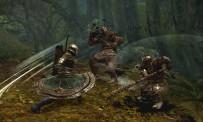 The setting is set for a good old hack'n slash in the northern lands of Middle-earth. And the term old is not overused. Because if the gameplay is not fundamentally bad, it dates back ten years. Your heroes cross levels which are all linear and completely marked corridors. So don't expect to wind around Rivendell. We advance, we rip open boxes and barrels to find money, we pick up equipment, we distribute slaps. And so on. Between each mission, the scenario makes sure to take you to a city, just to chat, to repair your weapons, to buy new ones, and to find side quests. A recipe that seems completely obsolete today in view of what is done by the competition. Luckily, the fights are relatively pleasant, or at least relaxing. The system is simple: a normal attack, a powerful attack and we bully until the enemy is weakened enough to land a critical hit. We then take the opportunity to cut off an arm, a leg or a head in a sheaf of blood. Enjoyable, despite the absence of combos that would have been a real friendlier. Dodging and parrying bring a little variety to the battles, as do the special abilities, which are relatively well thought out. Nevertheless, we can regret that there is not really a difference in playability between the three fighters. Some could quickly get tired of the fights, despite a fairly complete bestiary. The situations follow each other and resemble each other. Kill all enemies to unlock the passage, free a prisoner, open a door. We are a little bored, and we sometimes come up against more than tough minions, while the bosses do not represent real obstacles. A real problem because we often find ourselves having to do the housework alone because of the AI
The setting is set for a good old hack'n slash in the northern lands of Middle-earth. And the term old is not overused. Because if the gameplay is not fundamentally bad, it dates back ten years. Your heroes cross levels which are all linear and completely marked corridors. So don't expect to wind around Rivendell. We advance, we rip open boxes and barrels to find money, we pick up equipment, we distribute slaps. And so on. Between each mission, the scenario makes sure to take you to a city, just to chat, to repair your weapons, to buy new ones, and to find side quests. A recipe that seems completely obsolete today in view of what is done by the competition. Luckily, the fights are relatively pleasant, or at least relaxing. The system is simple: a normal attack, a powerful attack and we bully until the enemy is weakened enough to land a critical hit. We then take the opportunity to cut off an arm, a leg or a head in a sheaf of blood. Enjoyable, despite the absence of combos that would have been a real friendlier. Dodging and parrying bring a little variety to the battles, as do the special abilities, which are relatively well thought out. Nevertheless, we can regret that there is not really a difference in playability between the three fighters. Some could quickly get tired of the fights, despite a fairly complete bestiary. The situations follow each other and resemble each other. Kill all enemies to unlock the passage, free a prisoner, open a door. We are a little bored, and we sometimes come up against more than tough minions, while the bosses do not represent real obstacles. A real problem because we often find ourselves having to do the housework alone because of the AI
But by taking the side of an original adventure, Snowblind had to ensure the credibility of its story. A contract that is only partially fulfilled."
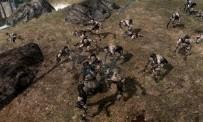 The companions, vast subject! They are indeed at the heart of one of the major problems of the game. From the beginning of the adventure, we are offered to choose one of our three Samaritans. So far, nothing out of the ordinary. Only, we quickly discover that it is completely impossible to have the slightest influence on our two friends, apart from a posture of defense or attack (difficult to see the difference between the two). There is no system of orders in the game and the two zozos do what they want. Without being profound morons, it is not uncommon for them to stay behind with their throwing weapons, the better to let you go to the coal. However, they use their abilities rather wisely, and come to revive you when necessary. But the main problem remains the management of their equipment: there is simply none! Impossible to choose the weapons and armor of your companions, and they dress a little with what comes to hand. Ditto for the objects: the inventories, which are also much too small, allow you to give items to your two companions, but no way to recover them. These two have bottomless pockets, which absorb tons of weapons and items without flinching. But there is worse. The game offers you the possibility to change heroes during the adventure, which is a good thing. We then say to ourselves that we will finally be able to equip the other characters as we feel it. Nay! Once the change is made, the one who is left out regains his independence. The AI chooses new equipment for no reason, and the character goes back to its original face! One wonders what logic led to such a result. Fortunately, the multi is there to catch up a bit. A friend can indeed give you a hand, online or in split screen. The game then gains a small, welcome tactical aspect, especially as the readability remains very correct.
The companions, vast subject! They are indeed at the heart of one of the major problems of the game. From the beginning of the adventure, we are offered to choose one of our three Samaritans. So far, nothing out of the ordinary. Only, we quickly discover that it is completely impossible to have the slightest influence on our two friends, apart from a posture of defense or attack (difficult to see the difference between the two). There is no system of orders in the game and the two zozos do what they want. Without being profound morons, it is not uncommon for them to stay behind with their throwing weapons, the better to let you go to the coal. However, they use their abilities rather wisely, and come to revive you when necessary. But the main problem remains the management of their equipment: there is simply none! Impossible to choose the weapons and armor of your companions, and they dress a little with what comes to hand. Ditto for the objects: the inventories, which are also much too small, allow you to give items to your two companions, but no way to recover them. These two have bottomless pockets, which absorb tons of weapons and items without flinching. But there is worse. The game offers you the possibility to change heroes during the adventure, which is a good thing. We then say to ourselves that we will finally be able to equip the other characters as we feel it. Nay! Once the change is made, the one who is left out regains his independence. The AI chooses new equipment for no reason, and the character goes back to its original face! One wonders what logic led to such a result. Fortunately, the multi is there to catch up a bit. A friend can indeed give you a hand, online or in split screen. The game then gains a small, welcome tactical aspect, especially as the readability remains very correct.
So close, yet so far...
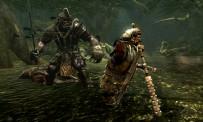 The companions, vast subject! They are indeed at the heart of one of the major problems of the title of Snowblind. From the beginning of the adventure, we are offered to choose one of our three Samaritans. So far, nothing out of the ordinary. Only, we quickly discover that it is completely impossible to have the slightest influence on our two friends, apart from a posture of defense or attack (difficult to see the difference between the two). There is no system of orders in the game and the other two zozos do what they want. Without being profound morons, it is not uncommon for them to stay behind with their throwing weapons, the better to let you go to the coal. However, they use their abilities more or less wisely, and come to revive you when necessary. But the main problem remains the management of their equipment: there is simply none! Impossible to choose the weapons and armor of your companions, and they dress a little with what comes to hand. Ditto for the objects: the inventories, which are also much too small, allow you to give items to your two companions, but no way to recover them. These two have magic pockets, which absorb tons of weapons and items without flinching. But there is worse. The game offers you the possibility to change characters during the adventure, which is a good thing. We say to ourselves "Nice, I'm going to equip the little furry one as I feel, I'm making it evolve, and I'm taking my Ranger for the next mission". Nay! Once the change of characters has been made, the Dwarf regains his independence, the AI chooses new equipment (probably at random), and the character takes back his original face!! One wonders what logic led the developers to such a result, but seen from here, it remains very obscure… Fortunately, the multiplayer is there to catch up a bit; a friend can indeed give you a hand, online or live. The game gains a small welcome tactical aspect, especially as the readability remains very correct.
The companions, vast subject! They are indeed at the heart of one of the major problems of the title of Snowblind. From the beginning of the adventure, we are offered to choose one of our three Samaritans. So far, nothing out of the ordinary. Only, we quickly discover that it is completely impossible to have the slightest influence on our two friends, apart from a posture of defense or attack (difficult to see the difference between the two). There is no system of orders in the game and the other two zozos do what they want. Without being profound morons, it is not uncommon for them to stay behind with their throwing weapons, the better to let you go to the coal. However, they use their abilities more or less wisely, and come to revive you when necessary. But the main problem remains the management of their equipment: there is simply none! Impossible to choose the weapons and armor of your companions, and they dress a little with what comes to hand. Ditto for the objects: the inventories, which are also much too small, allow you to give items to your two companions, but no way to recover them. These two have magic pockets, which absorb tons of weapons and items without flinching. But there is worse. The game offers you the possibility to change characters during the adventure, which is a good thing. We say to ourselves "Nice, I'm going to equip the little furry one as I feel, I'm making it evolve, and I'm taking my Ranger for the next mission". Nay! Once the change of characters has been made, the Dwarf regains his independence, the AI chooses new equipment (probably at random), and the character takes back his original face!! One wonders what logic led the developers to such a result, but seen from here, it remains very obscure… Fortunately, the multiplayer is there to catch up a bit; a friend can indeed give you a hand, online or live. The game gains a small welcome tactical aspect, especially as the readability remains very correct.
War in the North could have stood out within the series despite its flaws, if only Snowblind had taken a little more care in the making."
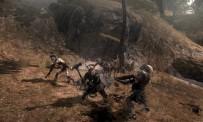 Fights that let off steam, an original and varied background: "War in the North" could have stood out within the series despite its flaws, if only Snowblind had taken a little more care in the production. Apart from the weapons and armor which are really pretty and stick perfectly to the different cultures created by Tolkien, the rest is just passable. In any case, it's generally unworthy of an HD console. However, with the mass of illustrations generated by artists like John Howe or Alan Lee, the inspiration is there. And the power of current machines should allow something dazzling. But no, the textures are dark and mundane, the animations are far from perfect, and the few open levels have only poor artwork as a horizon. We're tearing our hair out because of the catastrophic collision management, and the many bugs sometimes force us to quit the game. small consolation, especially when you see the vitality with which they participate in conversations. Moving the hands a little is the pinnacle of bodily expression here.
Fights that let off steam, an original and varied background: "War in the North" could have stood out within the series despite its flaws, if only Snowblind had taken a little more care in the production. Apart from the weapons and armor which are really pretty and stick perfectly to the different cultures created by Tolkien, the rest is just passable. In any case, it's generally unworthy of an HD console. However, with the mass of illustrations generated by artists like John Howe or Alan Lee, the inspiration is there. And the power of current machines should allow something dazzling. But no, the textures are dark and mundane, the animations are far from perfect, and the few open levels have only poor artwork as a horizon. We're tearing our hair out because of the catastrophic collision management, and the many bugs sometimes force us to quit the game. small consolation, especially when you see the vitality with which they participate in conversations. Moving the hands a little is the pinnacle of bodily expression here.
.
VIDEO TEST THE LORD OF THE RINGS: WAR IN THE NORTH
